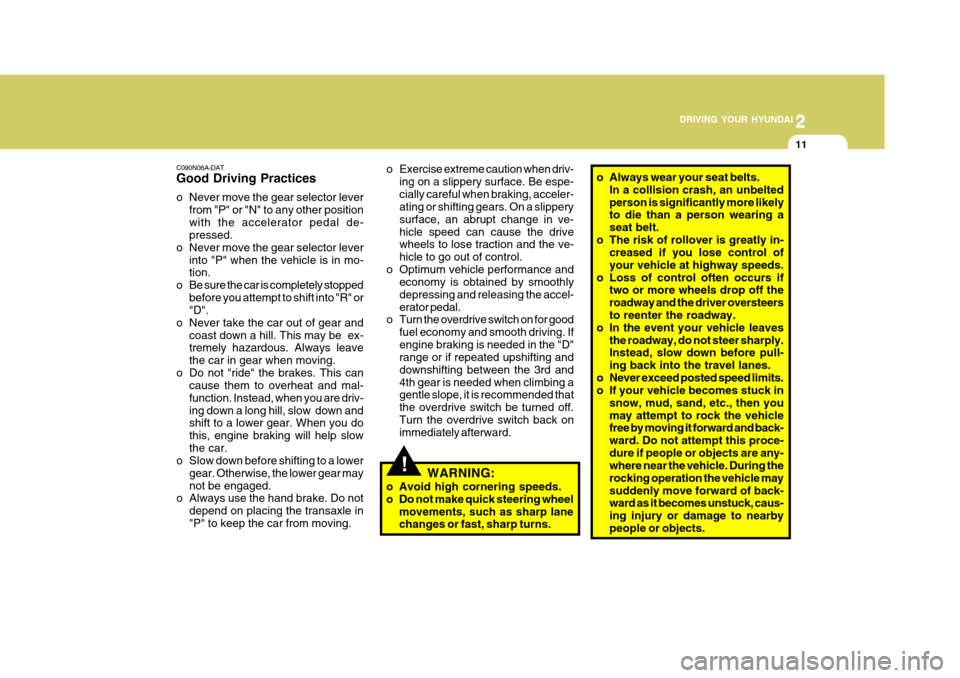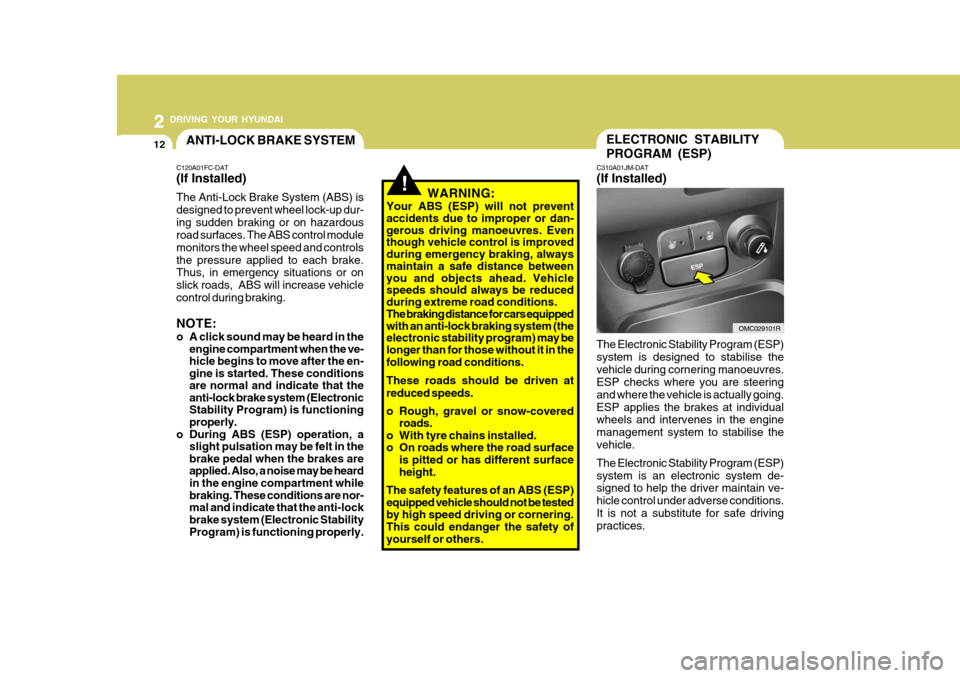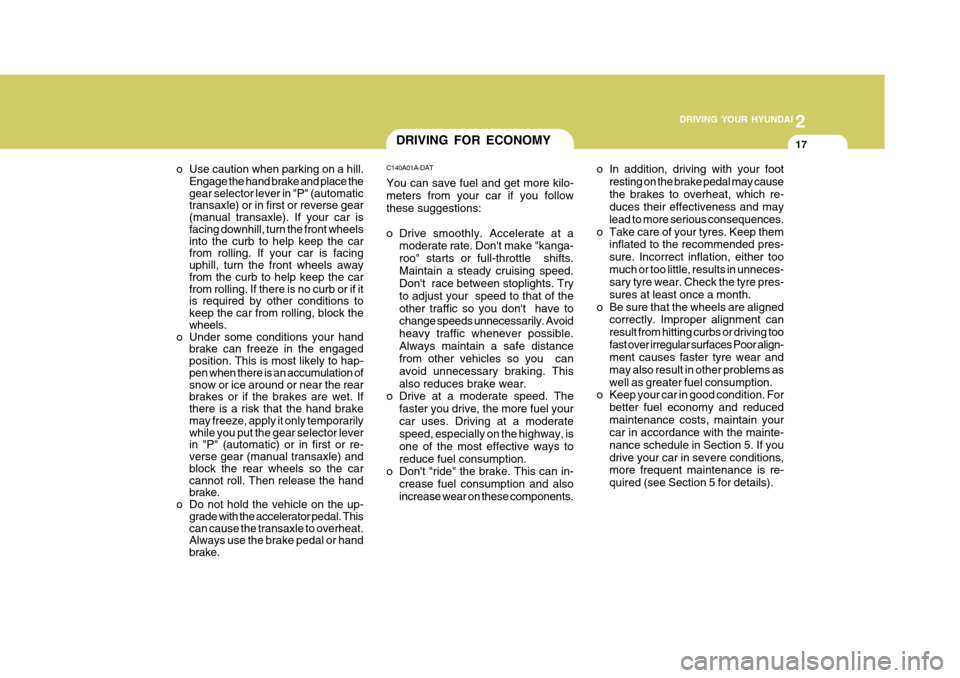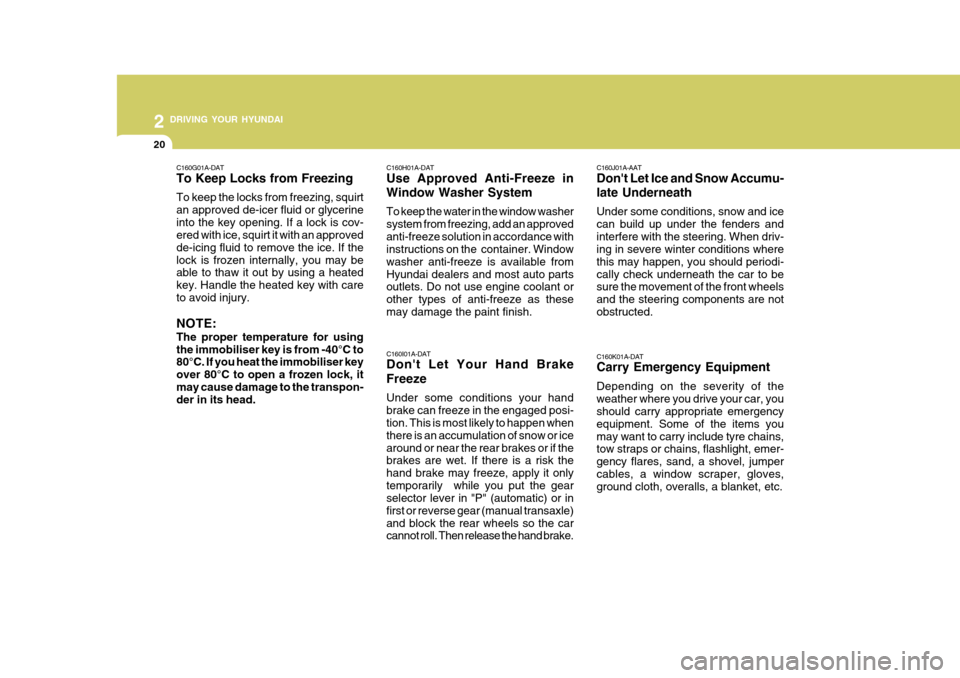2011 Hyundai Accent brake
[x] Cancel search: brakePage 138 of 232

2
DRIVING YOUR HYUNDAI
11
2
DRIVING YOUR HYUNDAI
11
!
C090N06A-DAT Good Driving Practices
o Never move the gear selector lever
from "P" or "N" to any other position with the accelerator pedal de- pressed.
o Never move the gear selector lever into "P" when the vehicle is in mo-tion.
o Be sure the car is completely stopped before you attempt to shift into "R" or"D".
o Never take the car out of gear and coast down a hill. This may be ex-tremely hazardous. Always leave the car in gear when moving.
o Do not "ride" the brakes. This can cause them to overheat and mal-function. Instead, when you are driv-ing down a long hill, slow down and shift to a lower gear. When you do this, engine braking will help slowthe car.
o Slow down before shifting to a lower
gear. Otherwise, the lower gear maynot be engaged.
o Always use the hand brake. Do not
depend on placing the transaxle in"P" to keep the car from moving. o Exercise extreme caution when driv-
ing on a slippery surface. Be espe-cially careful when braking, acceler- ating or shifting gears. On a slippery surface, an abrupt change in ve-hicle speed can cause the drive wheels to lose traction and the ve- hicle to go out of control.
o Optimum vehicle performance and economy is obtained by smoothlydepressing and releasing the accel-erator pedal.
o Turn the overdrive switch on for good
fuel economy and smooth driving. Ifengine braking is needed in the "D" range or if repeated upshifting and downshifting between the 3rd and4th gear is needed when climbing a gentle slope, it is recommended that the overdrive switch be turned off.Turn the overdrive switch back on immediately afterward.
WARNING:
o Avoid high cornering speeds.
o Do not make quick steering wheel movements, such as sharp lane changes or fast, sharp turns. o Always wear your seat belts.
In a collision crash, an unbelted person is significantly more likely to die than a person wearing a seat belt.
o The risk of rollover is greatly in- creased if you lose control ofyour vehicle at highway speeds.
o Loss of control often occurs if two or more wheels drop off theroadway and the driver oversteersto reenter the roadway.
o In the event your vehicle leaves
the roadway, do not steer sharply. Instead, slow down before pull- ing back into the travel lanes.
o Never exceed posted speed limits.
o If your vehicle becomes stuck in snow, mud, sand, etc., then you may attempt to rock the vehicle free by moving it forward and back- ward. Do not attempt this proce-dure if people or objects are any- where near the vehicle. During the rocking operation the vehicle maysuddenly move forward of back- ward as it becomes unstuck, caus- ing injury or damage to nearbypeople or objects.
Page 139 of 232

2 DRIVING YOUR HYUNDAI
12ANTI-LOCK BRAKE SYSTEMELECTRONIC STABILITY PROGRAM (ESP)
C310A01JM-DAT (If Installed)
OMC029101R
The Electronic Stability Program (ESP) system is designed to stabilise thevehicle during cornering manoeuvres. ESP checks where you are steering and where the vehicle is actually going.ESP applies the brakes at individual wheels and intervenes in the engine management system to stabilise thevehicle. The Electronic Stability Program (ESP) system is an electronic system de- signed to help the driver maintain ve- hicle control under adverse conditions.It is not a substitute for safe driving practices.
!WARNING:
Your ABS (ESP) will not prevent accidents due to improper or dan- gerous driving manoeuvres. Even though vehicle control is improved during emergency braking, always maintain a safe distance between you and objects ahead. Vehicle speeds should always be reduced during extreme road conditions. The braking distance for cars equipped
with an anti-lock braking system (the
electronic stability program) may be
longer than for those without it in the following road conditions. These roads should be driven at reduced speeds.
o Rough, gravel or snow-covered
roads.
o With tyre chains installed.
o On roads where the road surface is pitted or has different surface height.
The safety features of an ABS (ESP) equipped vehicle should not be testedby high speed driving or cornering.This could endanger the safety of yourself or others.
C120A01FC-DAT(If Installed) The Anti-Lock Brake System (ABS) is designed to prevent wheel lock-up dur-ing sudden braking or on hazardous road surfaces. The ABS control module monitors the wheel speed and controlsthe pressure applied to each brake. Thus, in emergency situations or on slick roads, ABS will increase vehiclecontrol during braking. NOTE:
o A click sound may be heard in the
engine compartment when the ve- hicle begins to move after the en-gine is started. These conditionsare normal and indicate that theanti-lock brake system (ElectronicStability Program) is functioning properly.
o During ABS (ESP) operation, a slight pulsation may be felt in the brake pedal when the brakes areapplied. Also, a noise may be heardin the engine compartment while braking. These conditions are nor- mal and indicate that the anti-lockbrake system (Electronic Stability Program) is functioning properly.
Page 142 of 232

2
DRIVING YOUR HYUNDAI
15
2
DRIVING YOUR HYUNDAI
15
CAUTION:
1. The rear parking assist warning may not sound sequentially de- pending on the speed and shapesof the objects detected.
2. The rear parking assist system
may malfunction if the vehiclebumper height or sensor installa- tion has been modified or dam- aged. Any non-factory installedequipment or accessories may also interfere with the sensor per- formance.
3. The sensor may not recognise objects less than 15 in. (40 cm)from the sensor, or it may sensean incorrect distance. Use cau- tion.
4. When the sensor is frozen or stained with snow, dirt, or water,the sensor may be inoperative until the stains are removed using asoft cloth.
5. Do not push, scratch or strike the
sensor. Sensor damage couldoccur.
!
4. Objects generating excessive noise
(vehicle horns, loud motorcycle en- gines, or truck air brakes) are within range of the sensor.
5. Heavy rain or water spray exists.
6. Wireless transmitters or mobile phones are within range of the sen-sor.
7. The sensor is covered with snow. 8. Trailer towing The detecting range may decrease when: 1. The sensor is stained with foreign matter such as snow or water. (The sensing range will return to normal when removed.)
2. Outside air temperature is extremely hot or cold.
The following objects may not be recognised by the sensor: 1. Sharp or slim objects such as ropes, chains or small poles.
2. Objects which tend to absorb the
sensor frequency such as clothes,spongy material or snow.
3. Undetectable objects smaller than 1
m (40 in.) and narrower than 14 cm (6in.) in diameter. CAUTION:
This system can only sense objects within the range and location of the sensors; It can not detect objects inother areas where sensors are not installed. Also, small or slim ob- jects, such as poles or objects lo-cated between sensors may not be detected by the sensors. Always visually check behind thevehicle when backing up. Be sure to inform any drivers of the vehicle that may be unfamiliar withthe system regarding the systems capabilities and limitations. Your new vehicle warranty does notcover any accidents or damage to the vehicle or its occupants due to a rear parking assist system malfunc-tion. Always drive safely and cau- tiously.!
Page 143 of 232

2 DRIVING YOUR HYUNDAI
16
o Don't coast down hills with the carout of gear. This is extremely haz- ardous. Keep the car in gear at all times, use the brakes to slow down, then shift to a lower gear so thatengine braking will help you main- tain a safe speed.
o Don't "ride" the brake pedal. Rest- ing your foot on the brake pedalwhile driving can be dangerous be- cause it can result in the brakesoverheating and losing their effec- tiveness. It also increases the wear of the brake components.
o If a tyre goes flat while you are driving, apply the brakes gently andkeep the car pointed straight aheadwhile you slow down. When you are moving slowly enough for it to be safe to do so, pull off the road andstop in a safe place.
o If your car is equipped with an auto-
matic transaxle, don't let your carcreep forward. To avoid creeping forward, keep your foot firmly on the brake pedal when the car is stopped.
!WARNING:
Pay close attention when the vehicle is driven close to objects on the road, particularly pedestrians, and especially children. Be aware thatsome objects may not be detected by the sensors, due to the object’s dis- tance, size or material, all of whichcan limit the effectiveness of the sensor. Always perform a visual inspection to make sure the vehicleis clear of all obstructions before moving the vehicle in any direction. NOTE: If you don’t hear an audible warning sound or if the buzzer sounds inter- mittently when shifting the gear to“R” position, this may indicate a malfunction in the rear parking as- sist system. If this occurs, have yourvehicle checked by an authorised Hyundai dealer as soon as possible.
!
GOOD BRAKING PRACTICES
C130A01A-DAT
WARNING:
Nothing should be carried on top of the shelf panel behind the rear seat.If there were an accident or a sud- den stop, such objects could move forward and cause damage to thevehicle or injure the occupants.
o After being parked, check to be sure the hand brake is not engaged and that the hand brake indicator light is out before driving away.
o Driving through water may get the brakes wet. They can also get wetwhen the car is washed. Wet brakescan be dangerous! Your car will not stop as quickly if the brakes are wet. Wet brakes may cause the car topull to one side. To dry the brakes, apply the brakes lightly until the braking action returns to normal,taking care to keep the car under control at all times. If the braking action does not return to normal,stop as soon as it is safe to do so and call your Hyundai dealer for assistance.
Page 144 of 232

2
DRIVING YOUR HYUNDAI
17
2
DRIVING YOUR HYUNDAI
17DRIVING FOR ECONOMY
C140A01A-DAT You can save fuel and get more kilo- meters from your car if you follow these suggestions:
o Drive smoothly. Accelerate at a moderate rate. Don't make "kanga- roo" starts or full-throttle shifts.Maintain a steady cruising speed. Don't race between stoplights. Try to adjust your speed to that of theother traffic so you don't have to change speeds unnecessarily. Avoid heavy traffic whenever possible.Always maintain a safe distance from other vehicles so you can avoid unnecessary braking. Thisalso reduces brake wear.
o Drive at a moderate speed. The
faster you drive, the more fuel yourcar uses. Driving at a moderate speed, especially on the highway, is one of the most effective ways toreduce fuel consumption.
o Don't "ride" the brake. This can in-
crease fuel consumption and alsoincrease wear on these components.
o Use caution when parking on a hill.
Engage the hand brake and place the gear selector lever in "P" (automatic transaxle) or in first or reverse gear (manual transaxle). If your car is facing downhill, turn the front wheels into the curb to help keep the car from rolling. If your car is facing uphill, turn the front wheels away from the curb to help keep the car from rolling. If there is no curb or if it is required by other conditions to keep the car from rolling, block the wheels.
o Under some conditions your hand brake can freeze in the engaged position. This is most likely to hap- pen when there is an accumulation of snow or ice around or near the rear brakes or if the brakes are wet. If there is a risk that the hand brake may freeze, apply it only temporarily while you put the gear selector lever in "P" (automatic) or in first or re- verse gear (manual transaxle) and block the rear wheels so the car cannot roll. Then release the hand brake.
o Do not hold the vehicle on the up- grade with the accelerator pedal. This can cause the transaxle to overheat. Always use the brake pedal or hand brake. o In addition, driving with your foot
resting on the brake pedal may cause the brakes to overheat, which re- duces their effectiveness and may lead to more serious consequences.
o Take care of your tyres. Keep them inflated to the recommended pres-sure. Incorrect inflation, either toomuch or too little, results in unneces- sary tyre wear. Check the tyre pres- sures at least once a month.
o Be sure that the wheels are aligned correctly. Improper alignment canresult from hitting curbs or driving toofast over irregular surfaces Poor align- ment causes faster tyre wear and may also result in other problems aswell as greater fuel consumption.
o Keep your car in good condition. For
better fuel economy and reducedmaintenance costs, maintain your car in accordance with the mainte- nance schedule in Section 5. If youdrive your car in severe conditions, more frequent maintenance is re- quired (see Section 5 for details).
Page 146 of 232

2
DRIVING YOUR HYUNDAI
19
2
DRIVING YOUR HYUNDAI
19
C160C01A-AAT Use High Quality Ethylene Gly- col Coolant Your Hyundai is delivered with high quality ethylene glycol coolant in the cooling system. It is the only type ofcoolant that should be used because it helps prevent corrosion in the cooling system, lubricates the water pump andprevents freezing. Be sure to replace or replenish your coolant in accor- dance with the maintenance schedulein Section 5. Before winter, have your coolant tested to assure that its freez- ing point is sufficient for the tempera-tures anticipated during the winter.
It should be noted that installing tyrechains on the tyre will provide a greaterdriving force, but will not prevent side skids. NOTE: Tyre chains are not legal in all states. Check state laws before fitting tyrechains.WINTER DRIVING
C160B01A-DAT Snowy or Icy Conditions To drive your vehicle in deep snow, it may be necessary to use snow tyres or to install tyre chains on your tyres. If snow tyre are needed, it is necessaryto select tyres equivalent in size and type to the original equipment tyres. Failure to do so may adversely affectthe safety and handling of your car. Furthermore, speeding, rapid accel- eration, sudden brake applications, andsharp turns are potentially very haz- ardous practices. During deceleration, use engine brak-ing to the fullest extent. Sudden brake applications on snowy or icy roads may cause skids to occur. You need to
keep sufficient distance between the vehicle in operation in front and your vehicle. Also, apply the brake gently.
C160A01A-DAT The more severe weather conditions of winter result in greater wear and other problems. To minimise the prob- lems of winter driving, you should fol-low these suggestions:
C160F02A-AAT Check Spark Plugs and Ignition System Inspect your spark plugs and replace them if necessary. Also check allignition wiring and components to be sure they are not cracked, worn or damaged in any way.
C160E01A-AAT Change to "Winter Weight" Oil if Necessary In some climates it is recommended that a lower viscosity "winter weight" oil be used during cold weather. See Section 9 for recommendations. If youaren't sure what weight oil you should use, consult your Hyundai dealer.
C160D01A-DAT Check Battery and Cables Winter puts additional burdens on the battery and charging system. Visuallyinspect the battery and cables as de- scribed in Section 6. The level of charge in your battery can be checked by yourHyundai dealer or a service station.
Page 147 of 232

2 DRIVING YOUR HYUNDAI
20
C160K01A-DAT Carry Emergency Equipment Depending on the severity of the weather where you drive your car, you should carry appropriate emergency equipment. Some of the items youmay want to carry include tyre chains, tow straps or chains, flashlight, emer- gency flares, sand, a shovel, jumpercables, a window scraper, gloves, ground cloth, overalls, a blanket, etc.
C160J01A-AAT Don't Let Ice and Snow Accumu- late Underneath Under some conditions, snow and ice can build up under the fenders andinterfere with the steering. When driv- ing in severe winter conditions where this may happen, you should periodi-cally check underneath the car to be sure the movement of the front wheels and the steering components are notobstructed.
C160G01A-DAT To Keep Locks from Freezing To keep the locks from freezing, squirt an approved de-icer fluid or glycerineinto the key opening. If a lock is cov- ered with ice, squirt it with an approved de-icing fluid to remove the ice. If thelock is frozen internally, you may be able to thaw it out by using a heated key. Handle the heated key with careto avoid injury. NOTE: The proper temperature for using the immobiliser key is from -40°C to 80°C. If you heat the immobiliser key over 80°C to open a frozen lock, itmay cause damage to the transpon- der in its head. C160H01A-DAT Use Approved Anti-Freeze in Window Washer System To keep the water in the window washer system from freezing, add an approvedanti-freeze solution in accordance with instructions on the container. Window washer anti-freeze is available fromHyundai dealers and most auto parts outlets. Do not use engine coolant or other types of anti-freeze as thesemay damage the paint finish. C160I01A-DAT Don't Let Your Hand Brake Freeze Under some conditions your hand brake can freeze in the engaged posi- tion. This is most likely to happen when there is an accumulation of snow or icearound or near the rear brakes or if the brakes are wet. If there is a risk the hand brake may freeze, apply it onlytemporarily while you put the gear selector lever in "P" (automatic) or in first or reverse gear (manual transaxle)and block the rear wheels so the car cannot roll. Then release the hand brake.
Page 149 of 232

2 DRIVING YOUR HYUNDAI
22
If the needle of the coolant tem- perature gauge moves across thedial towards "H" (HOT), pull over and stop as soon as it is safe to do so, and allow the engine toidle until it cools down. You may proceed once the engine has cooled sufficiently.
C190D02A-DAT Safety Chains Should the towbar connection between your car and the trailer or vehicle you are towing fail, the trailer or vehicle could wander dangerously across otherlanes of traffic and ultimately collide with another vehicle. To eliminate this potentially danger-ous situation, safety chains, attached between your car and the trailer or towed vehicle, are required in moststates.
!
C190B02S-DAT Trailer Towbars Select the proper towbar and ball com- bination, making sure that its location iscompatible with that of the trailer or vehicle being towed. We recommend only genuine Hyundai towbars (thetowbars are made and tested in Austra-
lia/NZ for local conditions). Use a qual- ity non-equalising towbar which distrib-utes the tongue load uniformly through- out the chassis. Tongue loads can be increased ordecreased by redistributing the load in the trailer. This can be verified by checking the total weight of the loadedtrailer and then checking the load on the tongue. WARNING:
Improperly loading your car and trailer can serious affect its steer-ing and braking performance caus- ing a crash in which you may be seriously injured. C190C01S-DAT Trailer Brakes If your trailer is equipped with a braking system, make sure it conforms to fed-eral and/or local regulations and that it is properly installed and operating cor- rectly. NOTE: If you tow a trailer or vehicle, your car will require more frequent main-tenance due to the additional load. See "Maintenance Under Severe Usage Conditions" on page 5-6.
!
CAUTION:
o Never connect a trailer brake sys- tem directly to the vehicle brake system.
o When towing a trailer on steep grades (in excess of 6%) pay closeattention to the engine coolant temperature gauge to ensure theengine does not overheat.